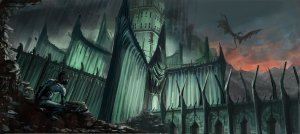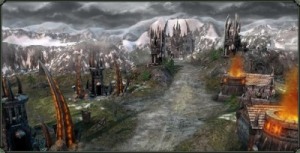Hail and Well Met Friends!
Over the next few weeks we will be taking a look into the history of the Witchking.
 They Have Arrived
They Have Arrived
The first sighting of the Nazgul in Middle-Earth was reported in the second age around year 2251. For the next 1200 years, the Lord of the Nazgul would serve Sauron as his second in command. He fought in the war against the Last Alliance of Elves and Men. It was in the second age when Sauron was finally defeated and the nine Nazgul disappeared from Middle-Earth.
One thousand years into the Third Age, Sauron took a new form as the Necromancer, and founded the fortress of Dol Guldur in southern Mirkwood. This signaled the return of the Nine Nazgul to Middle-Earth.
 The Witchking
The Witchking
The Lord of the Nazgul reappeared in the early part of the third age n the north near the lost realm of Arnor. There he founded the kingdom of Angmar. It was after the formation of Angmar and several conflicts with the Dunedain of the North that the Lord of the Nazgul received the title of Witch-king, Lord of Angmar.
He then began his open war campaign with the three divided kingdoms of Arnor (Arthedain, Rhudaur, and Cardolan). The Witch-king invaded the kingdom of Rhudaur and replaced the Dunedain king with a hill chief allied to Angmar. King Argeleb of Arthedain was killed trying to defend Rhudaur against Angmar. In the year 1409 the troops of the Witch-King assaulted the fortress of Amon Sul and burned the tower, during which conflict king Arveleg of Arthedain was killed. The Witch-King then invaded and destroyed the kingdom of Cardolan. Then the Witch-King invaded Arthedain and came close to destroying it but King Araphor with the help of the elves of Lindon and Rivendell managed to defeat the invading forces.
Soon, the only resistance against the Witch-king’s forces was the western kingdom of Arthedain. The Witch-king continued his war for hundreds of years. In year 1636, the Witch-king sent wights to the Barrow-downs in Cardolan in order to prevent the rebirth of the kingdom. The Witch-king claimed ultimate victory in the north many years later, when his forces captured Fornost, the capital of Arthedain. With its capture, the final kingdom collapsed, and with it, the last remnants of the lost realm of Arnor were destroyed.
 The Seat of Fornost
The Seat of Fornost
The Witch-king gladly took his seat of power in the newly captured Fornost. But his glory did not last long, as general Earnur of Gondor landed at the harbours of the Grey Havens, leading an army of Gondor. His army was joined by the Elves of Lindon and the remnant of the northern Dunedain and marched on the Witch-king.
They did not meet the Witch-king at Fornost, but on the plains west of it toward Lake Evendim, home of the ancient kings of Arnor, Annuminas. The battle would forever be known as the Battle of Fornost. Earnur’s Dunedain army was later joined in the mists of battle by Glorfindel and his Elven army from Rivendell.
The Witch-king revealed himself and challenged Earnur. As Earnur attempted to attack, his horse was overwhelmed with fear of the Nazgul lord and bucked him off. The Witch-king, taunting Earnur, fled the battlefield. When Earnur attempted to follow, Glorfindel stopped him with a warning that would become prophetic in the future: “Do not pursue him! He will not return to these lands. Far off yet is his doom, and not by the hand of man shall he fall.” The Witch-king, having destroyed the North-kingdom, fled the North. Angmar was left leaderless and soon collapsed.
Until next weeks series, I’m your host Iogro Merrybelly and I bid you a fine farewell!

Perhaps the Witchking was originally king of Angmar, or what was to become Angmar, before receiving a ring of power from Sauron.
Not a bad theory David, why not? perhaps the prince of Rhudaur, we can only imagine. It would make sense for the Witch King, the leader of the Nazgul to have Numenorean blood.
I believe that the theory is the Witch King is a black Numenorean (corrupted by Sauron) during the 2nd age. This would however be well before Arnor was divided into three kingdoms. It is most likely he would have been from Umbar or one of the other settlements.